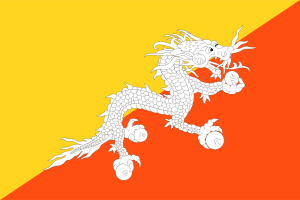
| Colors | HEX Code | RGB | CMYK |
|---|---|---|---|
| Yellow | #FFD520 | 255, 213, 32 | 0, 16, 87, 0 |
| White | #FFFFFF | 255, 255, 255 | 0, 0, 0, 0 |
| Orange | #FF4E12 | 255, 78, 18 | 0, 69, 93, 0 |
Bhutan is a landlocked country in South Asia that falls between India and Tibet. Its flag is made of two colors, orange and yellow, occurring in a diagonal pattern across the flag. On the flag, there is an image of a white dragon clutching jewels in its claws.
Meaning of the Bhutan flag
The yellow color stands for the royalty in Bhutan. It symbolizes the power of the king who is the head of the government. The orange color represents the Buddhist sects in the country. Consequently, the orange color represents the people of Bhutan themselves and their ethnic roots. It shows that the country is religiously committed. The white dragon is highly symbolic in Bhutan mythology since it represents the sound of thunder heard across the mountains and valleys, which was thought to be the voice of the dragon. The name of the country is derived from this myth, and Bhutan is called “the Land of the Thunder Dragon.” The jewels clutched in the claws of the dragon represent wealth and perfection.
History of the Bhutan Flag
The white dragon on the Bhutan flag was previously green, and it was inspired by the connections to China and the Chinese flags. . Bhutan was a closed country with little connection with the outer world. It had relations with Britain at the beginning of the 20th century, then it connected to the world through India during the 50s and 60s of the past century. The date of the official adaptation of the Bhutan current flag is unknown, but the flag is thought to be adopted after Bhutan joined the United Nations, where the need for an official flag emerged.